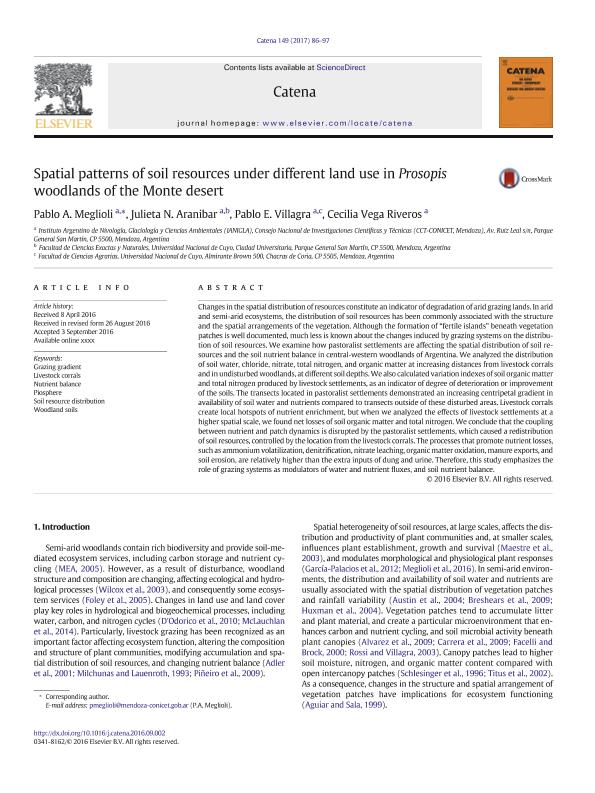Mostrar el registro sencillo del ítem
dc.contributor.author
Meglioli, Pablo Andrés

dc.contributor.author
Aranibar, Julieta Nelida

dc.contributor.author
Villagra, Pablo Eugenio

dc.contributor.author
Vega Riveros, Cecilia Carolina

dc.date.available
2018-11-05T15:14:49Z
dc.date.issued
2017-02
dc.identifier.citation
Meglioli, Pablo Andrés; Aranibar, Julieta Nelida; Villagra, Pablo Eugenio; Vega Riveros, Cecilia Carolina; Spatial patterns of soil resources under different land use in Prosopis woodlands of the Monte desert; Elsevier Science; Catena; 149; 2-2017; 86-97
dc.identifier.issn
0341-8162
dc.identifier.uri
http://hdl.handle.net/11336/63605
dc.description.abstract
Changes in the spatial distribution of resources constitute an indicator of degradation of arid grazing lands. In arid and semi-arid ecosystems, the distribution of soil resources has been commonly associated with the structure and the spatial arrangements of the vegetation. Although the formation of “fertile islands” beneath vegetation patches is well documented, much less is known about the changes induced by grazing systems on the distribution of soil resources. We examine how pastoralist settlements are affecting the spatial distribution of soil resources and the soil nutrient balance in central-western woodlands of Argentina. We analyzed the distribution of soil water, chloride, nitrate, total nitrogen, and organic matter at increasing distances from livestock corrals and in undisturbed woodlands, at different soil depths. We also calculated variation indexes of soil organic matter and total nitrogen produced by livestock settlements, as an indicator of degree of deterioration or improvement of the soils. The transects located in pastoralist settlements demonstrated an increasing centripetal gradient in availability of soil water and nutrients compared to transects outside of these disturbed areas. Livestock corrals create local hotspots of nutrient enrichment, but when we analyzed the effects of livestock settlements at a higher spatial scale, we found net losses of soil organic matter and total nitrogen. We conclude that the coupling between nutrient and patch dynamics is disrupted by the pastoralist settlements, which caused a redistribution of soil resources, controlled by the location from the livestock corrals. The processes that promote nutrient losses, such as ammonium volatilization, denitrification, nitrate leaching, organic matter oxidation, manure exports, and soil erosion, are relatively higher than the extra inputs of dung and urine. Therefore, this study emphasizes the role of grazing systems as modulators of water and nutrient fluxes, and soil nutrient balance.
dc.format
application/pdf
dc.language.iso
eng
dc.publisher
Elsevier Science

dc.rights
info:eu-repo/semantics/openAccess
dc.rights.uri
https://creativecommons.org/licenses/by-nc-sa/2.5/ar/
dc.subject
Grazing Gradient
dc.subject
Livestock Corrals
dc.subject
Nutrient Balance
dc.subject
Piosphere
dc.subject
Soil Resource Distribution
dc.subject
Woodland Soils
dc.subject.classification
Otras Ciencias Biológicas

dc.subject.classification
Ciencias Biológicas

dc.subject.classification
CIENCIAS NATURALES Y EXACTAS

dc.title
Spatial patterns of soil resources under different land use in Prosopis woodlands of the Monte desert
dc.type
info:eu-repo/semantics/article
dc.type
info:ar-repo/semantics/artículo
dc.type
info:eu-repo/semantics/publishedVersion
dc.date.updated
2018-10-23T14:41:33Z
dc.journal.volume
149
dc.journal.pagination
86-97
dc.journal.pais
Países Bajos

dc.journal.ciudad
Amsterdam
dc.description.fil
Fil: Meglioli, Pablo Andrés. Consejo Nacional de Investigaciones Científicas y Técnicas. Centro Científico Tecnológico Conicet - Mendoza. Instituto Argentino de Nivología, Glaciología y Ciencias Ambientales. Provincia de Mendoza. Instituto Argentino de Nivología, Glaciología y Ciencias Ambientales. Universidad Nacional de Cuyo. Instituto Argentino de Nivología, Glaciología y Ciencias Ambientales; Argentina
dc.description.fil
Fil: Aranibar, Julieta Nelida. Consejo Nacional de Investigaciones Científicas y Técnicas. Centro Científico Tecnológico Conicet - Mendoza. Instituto Argentino de Nivología, Glaciología y Ciencias Ambientales. Provincia de Mendoza. Instituto Argentino de Nivología, Glaciología y Ciencias Ambientales. Universidad Nacional de Cuyo. Instituto Argentino de Nivología, Glaciología y Ciencias Ambientales; Argentina. Universidad Nacional de Cuyo. Facultad de Ciencias Exactas y Naturales; Argentina
dc.description.fil
Fil: Villagra, Pablo Eugenio. Consejo Nacional de Investigaciones Científicas y Técnicas. Centro Científico Tecnológico Conicet - Mendoza. Instituto Argentino de Nivología, Glaciología y Ciencias Ambientales. Provincia de Mendoza. Instituto Argentino de Nivología, Glaciología y Ciencias Ambientales. Universidad Nacional de Cuyo. Instituto Argentino de Nivología, Glaciología y Ciencias Ambientales; Argentina. Universidad Nacional de Cuyo. Facultad de Ciencias Agrarias; Argentina
dc.description.fil
Fil: Vega Riveros, Cecilia Carolina. Consejo Nacional de Investigaciones Científicas y Técnicas. Centro Científico Tecnológico Conicet - Mendoza. Instituto Argentino de Nivología, Glaciología y Ciencias Ambientales. Provincia de Mendoza. Instituto Argentino de Nivología, Glaciología y Ciencias Ambientales. Universidad Nacional de Cuyo. Instituto Argentino de Nivología, Glaciología y Ciencias Ambientales; Argentina
dc.journal.title
Catena

dc.relation.alternativeid
info:eu-repo/semantics/altIdentifier/doi/https://dx.doi.org/10.1016/j.catena.2016.09.002
dc.relation.alternativeid
info:eu-repo/semantics/altIdentifier/url/https://linkinghub.elsevier.com/retrieve/pii/S0341816216303630
Archivos asociados
